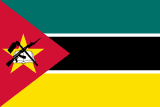Gender Quotas Database

Mozambique
Eastern Africa
Single / Lower House
Assembleia da Republica / Assembly of the Republic
| Total seats | 250 |
| Total women | 0 |
| Percentage of women | 0% |
| Gender Quota target | |
| Election year | 2024 |
| Electoral system | List PR |
| Quota type | |
| Election details | IDEA Voter Turnout - IPU Parline |
Voluntary Political Party Quotas*
| Party | Official Name | Details, Quota provisions |
|---|---|---|
| Front for the Liberation of Mozambique | Frente de Libertação de Moçambique (FRELIMO) |
FRELIMO has used gender quotas since 1994. The party's policy requires that 40% of candidates to national assembly and local government should be women. In addition, the quota system was accompanied by a commitment to balance the distribution of men and women through the list. Currently, FRELIMO holds 191 seats of a total of 250 in the national assembly, in effect a three-fourths majority. |
| Mozambican National Resistance | Resistência Nacional Moçambicana (RENAMO) |
a) The National Council is composedby 120 members elected by Congress.Two) In the process of electing membersof the National Council, the principle is observedrepresentation of provinces and gender.(Article 28 (2) of the Party Statutes) |
* Only political parties represented in parliament are included. When a country has legislated quotas in place, only political parties that have voluntary quotas that exceed the percentage/number of the national quota legislation are presented in this table.
Additional information
11 November 2019:
"Women’s representation in parliament in Mozambique decreased by 2 percentage points the October elections. While Mozambique is one of the better performers in the Southern African development Community (SADC) the failure to reach gender parity in these elections is a serious set-back. “We have only two elections to go before the 2030 deadline for the Sustainable development Goals and the SADC on Gender and Development,” noted GL Lusophone Alice Banze. “A legislated quota is a necessary pre-requisite for equal representation,” she added.
[...] The election results show that it is time for reflection and action towards the 2024 election. There is need to engage with the public, particularly women who constitute the majority of voters about what they want from government. Political parties need to present plans and strategies that advance gender equality and women’s rights" (Genderlinks.org November 2019)
Sources
LEGAL SOURCES:
- Constitution on Mozambique - Link
- Electoral Law (amended through 2019) - Link
- Political Parties Law (amended through 2004) - Link
- Local Government Law 3/2019 - Link
OTHER SOURCES:
- Parliament of Mozambique - Link
- Electoral Commission - Link
- Electoral Institute for Sustainable Democracy in Africa [EISA]
- SADC Gender Protocol 2011 Barometer
- Genderlinks.org (November 2019) Gender Parity in Mozambique Parliament Elusive. [Accessed March 2021]
- Genderlinks.org (November 2019) Gender Parity in Mozambique Parliament Elusive. [Accessed March 2021]
Additional reading
- See the latest updates on Mozambique on iKNOW Politics
- The Carter Center, NGO Submission to the U.N Committee on the Elimination of All Forms of Discrimination Against Women Session 73, July 2019, Mozambique
- Yoon, M. Y. 2001. Democratization and Women's Legislative Representation in Sub-Saharan Africa. Democratization, 8(2), pp. 169-190.
- Kethusegile, B. et al. 2000. Beyond Inequalities: Women in Southern Africa. Harare: SARDC.
- Lowe-Morna, C. 2000. ‘Strategies for Increasing Women's Participation in Politics’, paper presented to the Fifth Meeting of Commonwealth Ministers Responsible for Women's Affairs.
- Inter-Parliamentary Union [IPU]. 1997. Democracy Still in the Making: A World Comparative Study. Geneva: Inter-Parliamentary Union.
- Jacobson, R. 1996. ‘Genderand Democratisation: The Mozambican Election of 1994’, Internet Journal of African Studies, No.1.
Explore more resources: Africa | Global
Know about useful additional reading for Mozambique? Tell us!
Submit feedback
Submit questions or comments about the Data or Tool
How did you find out about this? What do you like about it? What did you expect but did not find in using the Data or Tool?
To see how we handle your personal data, please read our Privacy Policy.
